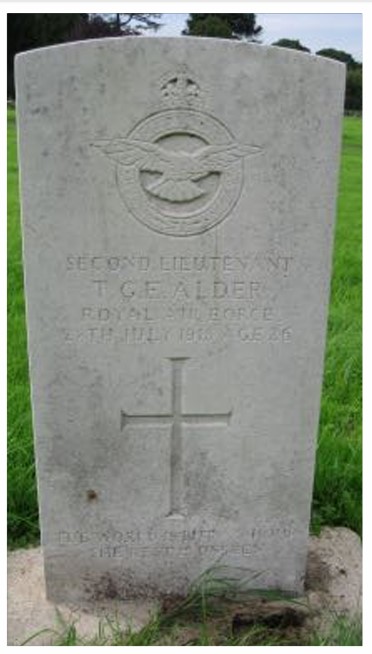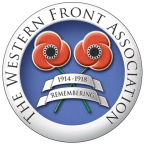Royal Air Force

Thomas Gordon Edgecombe Alder was born in Gloucester on 1 May 1892, the eldest son of Emanuel Benjamin Alder and his wife Kate. The family lived at Milford Villa, 50 Hanman Road, Gloucester.
Upon leaving Ryecroft Technical School, Gloucester, in 1906, where he was a chorister (and the first member of the choir to volunteer) he was employed as a junior clerk and cashier for the Co- op Industrial Society, Gloucester and was assistant cashier at Cheltenham when war broke out.
According to his Medal Index Card (MIC) he originally served as 2987 Serjeant in the 2/5th Battalion, Gloucestershire Regiment, before being commissioned as a Second Lieutenant in the 5th Battalion, East Lancashire Regiment on 26 September 1917. He later transferred to the Royal Flying Corps and was present when that body was absorbed into the Royal Air Force on 1 April 1918.
He originally enlisted for the duration of the war, agreeing to serve overseas if required on 9 September 1914 and was posted to 2/5th Glosters. He was soon appointed a Lance Corporal (1 October 1914) and became an Acting Corporal on 30 January 1915. In December 1915 he had qualified as a First Class Instructor at the School of Musketry, Bisley. His appointment to Temporary Acting Serjeant came on 1 May 1915 and the temporary attachment was dropped on 17 July 1915 before he achieved substantive rank of Serjeant on 24 May 1916. This coincided with embarkation for France from Southampton on that date, arriving at Le Havre on the following day. On 24 August 1916 he was slightly injured when a Newton Pippin rifle grenade burst prematurely during instructional practice.
He remained in France until 2 March 1917, when he returned to the UK as a candidate to receive an Officer’s Commission. He received this on 28 September 1917 and was posted to 5th Battalion, East Lancashire Regiment. Within a couple of months he had applied to join the Royal Flying Corps and on 16 November 1917 was examined as to his fitness to be a pilot. He reported to the No 1 School of Military Aeronautics, Reading on 8 December 1917, for training as a pilot. He was posted to 37 Training Depot Station, Yatesbury, Wiltshire on 6 April 1918.
The Gloucester Journal of 3 August 1918 throws some light on his war service. It states that he enlisted early in the war and had been promoted to Serjeant by the time he went to France in 1915 (the MIC states, correctly, this was in May 1916). He took part in the Somme offensive and was wounded and upon return to duty was recommended for a commission. It reported that he had been in training for six months when he was killed. This would place the transfer at the beginning of 1918.
The above newspaper stated that he had obtained his wings and qualified as a pilot and was expecting a posting to France when he was accidentally killed whilst flying in Hampshire (near Stockbridge) on the morning of Sunday, 28 July 1918. According to Airmen Died in the Great War he was serving with 3 Training Depot Station when he died and was flying a Sopwith Camel (serial number C1646). That unit was based at Lopcombe Corner aerodrome, on the Hampshire/ Wiltshire border.
He was buried in Gloucester Old Cemetery, where a CWGC headstone marks his grave.
Graham Adams
(Gloucestershire War Graves Project biographical archive)
